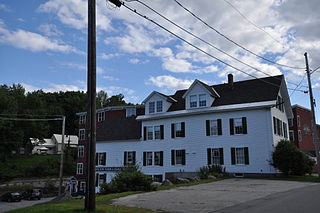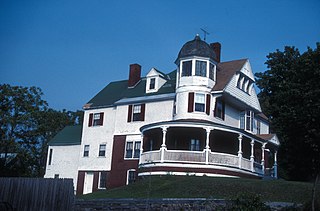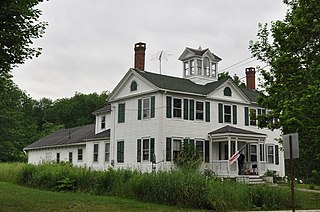
The A. A. Garcelon House is a historic house in the Main Street Historic District in Auburn, Maine. Built in 1890 for a prominent local businessman, it is one of the city's finest examples of Queen Anne Victorian architecture. It was listed on the National Register of Historic Places on June 13, 1986.

The Holman Day House is a historic house at 2 Goff Street in Auburn, Maine. Built in 1895, it is one of the state's finest examples of Queen Anne architecture, and is further notable as the home of Maine author Holman Day. It was listed on the National Register of Historic Places in 1978.

The Chamberlin House is a historic house at 44 Pleasant Street in Concord, New Hampshire. Built in 1886, it is a prominent local example of Queen Anne architecture built from mail-order plans, and now serves as the clubhouse of the Concord Women's Club. It was listed on the National Register of Historic Places in 1982.

The Bass Boarding House is an historic house on Canal Street in Wilton, Maine, United States. It was built in 1860s, and adapted for use as worker housing for G.H. Bass & Co., whose former factory building stands next door. The building, one of a few that survive in Wilton that were adapted in this way, was added to the National Register of Historic Places in 1988. It now houses the Wilton Historical Society's Wilton Farm and Home Museum.

The Ora Blanchard House is an historic house at the junction of Maine State Routes 16 and 27 in the center of Stratton, Maine, United States. Also known as Widow's Walk, this wood-frame house, built in 1892, is by far the most distinctive house in the small community, exhibiting a creative collection of Queen Anne features in a remote rural area. It was listed on the National Register of Historic Places in 1980.

The Jonesborough Historic District is a historic district in Jonesborough, Tennessee, that was listed on the National Register of Historic Places as Jonesboro Historic District in 1969.

The Lord-Dane House is a historic house in Alfred, York County, Maine. Built in about 1903 as a country retreat for a ship's captain, it is a high-quality example of Federal architecture in a rural context. The house was added to the National Register of Historic Places in 1992.

The Henry Richardi House is located at 402 North Bridge Street in Bellaire, Michigan. It was originally built for Henry Richardi, a late 19th century lumber baron and industrialist, reportedly in an attempt to woo a young woman for a wife. It currently operates as the "Grand Victorian Bed and Breakfast." It was listed on the National Register of Historic Places in 1978.

The J.G. Deering House also known as the Dyer Library/Saco Museum is an historic house at 371 Main Street in Saco, Maine. Completed in 1870, it is a fine local example of Italianate style. Built for Joseph Godfrey Deering, it was given by his heirs to the city for use as a library. It was listed on the National Register of Historic Places in 1982.

The Broad Street Historic District encompasses a significant portion of the historic center of Bethel, Maine. Broad Street dates to the early days of Bethel's settlement in the early 19th century, and its town common was a gift from the first settler of the area. As originally listed on the National Register of Historic Places in 1977, the district included the common and a section of Broad Street between Main Street and Paradise Hill Road. This was expanded in 1990 along Church Street to encompass historic homes and a portion of the Gould Academy campus.

The Gehring Clinic is a historic house and medical facility at the south end of Broad Street Historic District in Bethel, Maine. Built in 1896 for Doctor John George Gehring, it is a fine local example of Queen Anne architecture. It is recognized, however, for its association with Gehring, a nationally known psychotherapist who was an early proponent of the use of hypnosis to treat nervous disorders. Gehring opened his large home as a rest home for those who traveled to Bethel to receive his treatment. The property was listed on the National Register of Historic Places in 1976.

The Samuel D. Philbrook House is a historic house at 162 Main Street in Bethel, Maine. Built in 1878-79 by a local businessman, it is probably the most elaborate Italianate residence in the community, and one of the finest of the type in Oxford County. It now houses a retail space in the first floor and attached barn, with living space above. It was listed on the National Register of Historic Places in 1995.

The Gould House is a historic house at 31 Elm Street in Skowhegan, Maine. Built in 1887 by a prominent local lawyer and businessman, it is one of the finest examples of Queen Anne architecture in the interior of Maine. It was listed on the National Register of Historic Places in 1982.

The William M. Shaw House is a historic house located at 40 Norris Street in Greenville, Maine, which now houses the Greenville Inn. Built in 1895, it is a handsome and elaborate example of Queen Anne architecture in a rural small-town setting. The house was designed by Edwin E. Lewis of Gardiner, with alterations by Wilfred E. Mansur of Bangor. The house was listed on the National Register of Historic Places in 2013 for its architecture, and for its association with William Shaw, a leading lumber businessman active in Greenville in the late 19th and early 20th centuries, whose business interests also included ownership of the steamer Katahdin.

The David W. Campbell House is a historic house on Main Street in Cherryfield, Maine. Built in 1828 as a Federal-style structure, it was altered in the mid-19th century to include a significant number of Italianate features. Built by a member of the locally prominent Campbell family, it was listed on the National Register of Historic Places in 1990 for its architectural significance, and is a contributing member of the 1990 Cherryfield Historic District.
John N. Philbrook (1840–1923) was an American politician from Maine. A Republican, Philbrook served a term in the Maine House of Representatives (1893-1894) and in the Maine Senate (1903-1904) from Bethel, Maine. He also served as an Oxford County Commissioner. The John Philbrook House in Bethel was built by Philbrook and is named in his honor. It is on the National Register of Historic Places.

The Col. Samuel Campbell House is a historic house on United States Route 1 in the village center of Cherryfield, Maine. Built in 1883, it is one of the finest examples of Queen Anne Victorian architecture in eastern Maine. The house was listed on the National Register of Historic Places in 1982, and is a contributing element of the 1990 Cherryfield Historic District.
The Captain John Plummer House is a historic house at 23 Pleasant Street in Addison, Maine. Built in 1842 for a ship's captain and local politician, it is locally distinctive for its Gothic Revival entry vestibule, an architectural style not found elsewhere in the small community. The house was listed on the National Register of Historic Places in 2009.

The Harrington House is a historic house at 88 North Road in Bethel, Vermont. Built in 1890–91, it is a fine example of high-style Queen Anne Victorian architecture, a relative rarity in the state. The house was listed on the National Register of Historic Places in 1983. Its most recent additions have included a restaurant, bed and breakfast inn.

The Reynolds House, currently the Reynolds House Inn, is a historic house at 102 South Main Street in the city of Barre, Vermont. Built in the 1890s, it is a well-preserved high-style example of Late Victorian architecture, exhibiting both Queen Anne and Second Empire features. Built for a local merchant, it is a rare survivor of what was once a series of high-profile residences south of downtown Barre. It was listed on the National Register of Historic Places in 2020.




















